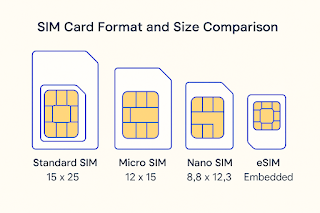Standard vs Micro vs Nano vs eSIM – Which SIM Card Do You Need?
SIM Card Format and Size Comparison – Know What Fits
Ever tried inserting a SIM card into a new phone and found it doesn’t fit? You’re not alone. With multiple SIM formats in use today, it can get confusing. In this post, we’ll break down the different SIM card sizes, their uses, and help you understand which one is right for your device.
What is a SIM Card?
SIM stands for Subscriber Identity Module. It’s a small chip that allows your phone to connect to your mobile network. It holds your mobile number, network details, and a small amount of data like contacts or SMS. Without a SIM, your phone can't make calls or use mobile data.
Types of SIM Cards
| Type | Size (mm) | Introduced | Common Devices |
|---|---|---|---|
| Standard SIM | 25 x 15 | 1996 | Old feature phones |
| Micro SIM | 15 x 12 | 2003 | iPhone 4, Galaxy S3 |
| Nano SIM | 12.3 x 8.8 | 2012 | Modern smartphones |
| eSIM | Embedded | 2016 | iPhones, Pixel, Wearables |
Standard SIM: The Original
This is the first-generation SIM and also the biggest. It was commonly used in feature phones and early smartphones. With newer phones being thinner, the large plastic frame became impractical. These are now outdated.
Micro SIM: A Slimmer Option
The Micro SIM came next, reducing the plastic around the chip. It became standard for many phones around 2010. Popular devices like the iPhone 4 and Galaxy S3 used this format. It's rarely used in new devices today.
Nano SIM: Current Standard
Almost all smartphones today use Nano SIMs. Introduced in 2012, the Nano SIM is all chip with very little plastic. It’s smaller, more efficient, and helps save internal space in modern devices.
eSIM: The Future is Digital
eSIM stands for Embedded SIM. There’s no physical card. It’s built into your phone and activated by scanning a QR code. eSIM is great for dual SIM functionality and remote switching between networks. It’s available on recent iPhones, Google Pixels, and premium wearables.
Summary of SIM Card Sizes
- Standard SIM: 25 x 15 mm – Obsolete now
- Micro SIM: 15 x 12 mm – Limited usage
- Nano SIM: 12.3 x 8.8 mm – Most common
- eSIM: Embedded – No card needed
Why SIM Sizes Keep Shrinking
As smartphones become more compact, manufacturers reduce component sizes to make room for better cameras, larger batteries, and more sensors. A smaller SIM saves space inside the phone, which can be used for other tech improvements.
Triple-Cut SIMs and Adapters
Modern SIMs are usually provided in all sizes. The card you receive often includes all three cutouts – Standard, Micro, and Nano. You simply push out the size you need. If you're switching back to an older phone, adapters can help convert a Nano SIM into a Micro or Standard format.
Risks of Cutting Your SIM
While it’s possible to cut a Standard or Micro SIM into a smaller size, doing so may damage the chip. If done incorrectly, your phone might not read the card at all. It’s safer to get a new SIM from your carrier or use a proper cutter tool.
Dual SIM Phones
Dual SIM phones allow two numbers on the same device. Some have two physical SIM slots; others use one Nano SIM and one eSIM. This is great for travelers, work-life separation, or juggling personal and business lines.
Is eSIM Better?
eSIM offers many advantages: you can activate it instantly, change networks without a physical card, and even use dual profiles on one device. But not all phones or carriers support it yet. It's the future, but we’re still in a transition phase.
Quick Tips Before Changing SIMs
- Always check your device’s SIM card size before ordering or cutting
- Request a triple-cut SIM if unsure
- Store old adapters safely if you switch phones often
- Use a SIM ejector pin or paperclip to open the SIM tray carefully
Conclusion
Knowing your SIM card format saves you time, frustration, and sometimes even money. As mobile tech continues to evolve, smaller and smarter SIM formats like eSIM are leading the way. Whether you're on an older feature phone or the latest flagship, understanding your SIM format is key to staying connected.
Thanks for reading! If you found this comparison helpful, consider sharing it with friends who are switching phones or struggling with SIM compatibility.


.jpeg)
Comments
Post a Comment